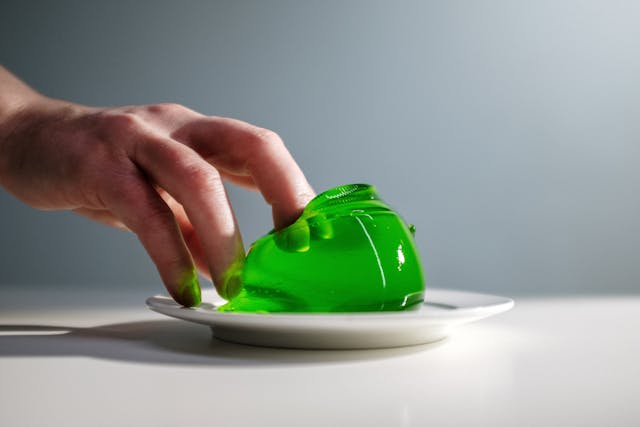
Why does gelatin set? Gelatin sets because the protein strands in it go soft when they are heated and then form into a tangled mass when they cool.
Gelatin is an ingredient we use for cooking and it is taken from the collagen found in animal parts. You can get vegan gelatin, but unless it says “vegan” on it, then it has come from an animal. Collagen is one of the most common proteins in our bodies and most animals’ bodies. It is made from amino acids that come together to make three proteins. These are proline, glycine, and hydroxyproline. The three proteins come together in a triple helix, which gives collagen strength and flexibility. It is so common in our bodies because it is so useful. You can find it in our skin, muscles, bones, cartilage, ligaments, tendons, inside organs, and in all of the tissue that connects them. The same is true in all animals.
Gelatin is made by the meat industry and the leather industry, and it is a byproduct that they don’t need. The most common sources of gelatin are pig and cow skins, or pig and cow bones. To get at the collagen, the parts have to be cleaned of all meat and fat. Then the animal parts are soaked in an alkaline solution for a few weeks to loosen up the collagen. Finally, they are mixed with hot water, and the collagen washes out of them. It can then be dried into gelatin. Gelatin can also be made from fish, and you can buy vegan gelatin these days as well. Vegan gelatin is made from plants that have a lot of these proteins, such as seaweed or algae. Vegan gelatin has less protein than animal based gelatin, but it does dissolve at a lower temperature and can set without being refrigerated.
So, how does gelatin set? To use gelatin, you first need to boil it. The protein chains in cold gelatin are long, strong, and coiled. When you boil the gelatin, these coils soften and the protein chains break up into small pieces. In this state, they can move around in the liquid very easily. When they cool down, the pieces of protein attach to each other, and they make a mesh with pockets that can fill with water. This makes the gelatin mostly solid, but still flexible. It is not actually a solid, though. It is called an amorphous solid, which means it has the properties of both solids and liquids.
The most common gelatin product that we eat is jelly (Jell-O), which is made from gelatin, water, sugar, flavoring, and food coloring. However, there are a lot of other jellied products, and it is was fairly common before the invention of the refrigerator. Jellied meats and jellied fish were very common because the gelatin forms a protective layer around the meat, keeping out air and bacteria. Jellied food will last much longer, and it was common to jellify meat after a meal was finished to keep what was left. Because of this, savory jellies were the norm. Sweet dessert jellies only appeared in the 18th century. Gelatin made from the feet of calves was mixed with fruit juice and sugar, and then colored with food coloring. It was called “calf’s foot jelly”, which doesn’t sound very appealing. At that time, all gelatine had to be made at home by boiling animal bones for a long time. Making a dessert was such a time-consuming process that only wealthy people with a kitchen staff could really eat it. Having a jelly mold in the house was a symbol of status. These molds became increasingly complex.
It was only in 1845, when an industrialist called Peter Cooper worked out how to make powdered gelatin, that jelly became cheaper and easier to eat. The rise of jellies, such as the American Jell-,O is interesting because it mirrors the changes in society over the century from 1850 to 1950. Refrigerators were introduced and became popular, which allowed people to make jelly desserts more easily. The distribution network of the rising supermarkets favored simple things like packet jellies that were easy to ship, cheap, and lasted a long time. The rising working and middle classes wanted easier meals, and a host of labor-saving devices were introduced. Communities changed as well. After World War 2, young people moved away from their families and the towns they grew up in for new opportunities, and the supportive community structures disappeared. Children used to be raised by a whole community, but now they were raised by the mother, on her own. There wasn’t the time to cook intricate meals, and ready meals, such as jelly, became standard. And this is what I learned today.
Sources
https://en.wikipedia.org/wiki/Gelatin
https://en.wikipedia.org/wiki/Gelatine_dessert
https://en.wikipedia.org/wiki/Jell-O
https://en.wikipedia.org/wiki/Collagen
https://my.clevelandclinic.org/health/articles/23089-collagen
https://en.wikipedia.org/wiki/Aspic
Photo by cottonbro studio: https://www.pexels.com/photo/photo-of-green-jelly-on-plate-4631891/
